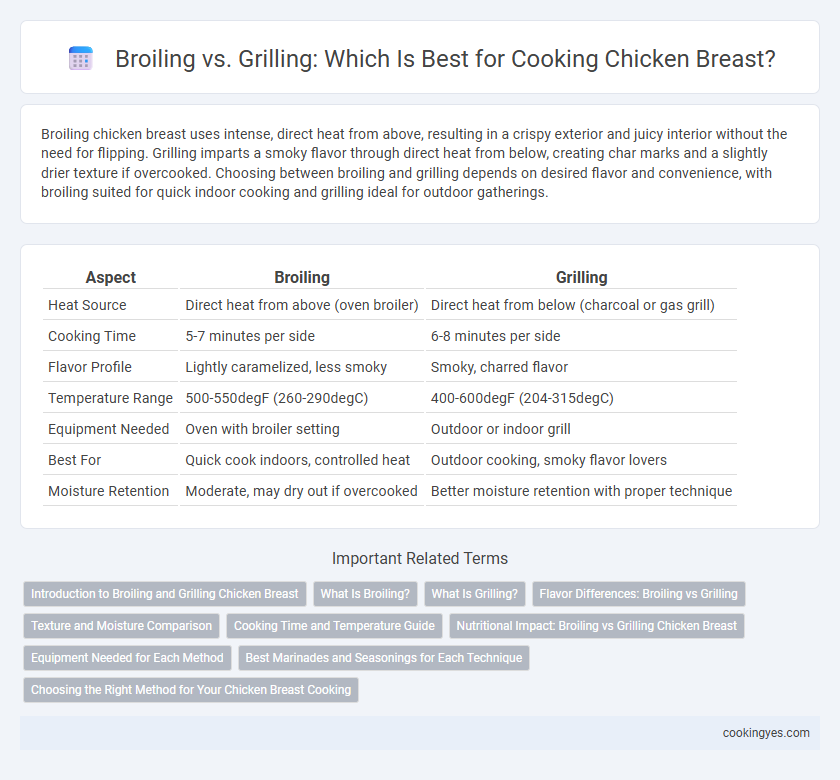Broiling chicken breast uses intense, direct heat from above, resulting in a crispy exterior and juicy interior without the need for flipping. Grilling imparts a smoky flavor through direct heat from below, creating char marks and a slightly drier texture if overcooked. Choosing between broiling and grilling depends on desired flavor and convenience, with broiling suited for quick indoor cooking and grilling ideal for outdoor gatherings.
Table of Comparison
| Aspect | Broiling | Grilling |
|---|---|---|
| Heat Source | Direct heat from above (oven broiler) | Direct heat from below (charcoal or gas grill) |
| Cooking Time | 5-7 minutes per side | 6-8 minutes per side |
| Flavor Profile | Lightly caramelized, less smoky | Smoky, charred flavor |
| Temperature Range | 500-550degF (260-290degC) | 400-600degF (204-315degC) |
| Equipment Needed | Oven with broiler setting | Outdoor or indoor grill |
| Best For | Quick cook indoors, controlled heat | Outdoor cooking, smoky flavor lovers |
| Moisture Retention | Moderate, may dry out if overcooked | Better moisture retention with proper technique |
Introduction to Broiling and Grilling Chicken Breast
Broiling chicken breast involves cooking it under direct high heat in an oven, which quickly sears the surface, locking in juices and creating a caramelized exterior. Grilling chicken breast exposes it to open flame or charcoal, imparting a smoky flavor and distinct grill marks while cooking through radiant heat. Both methods offer fast cooking times and emphasize retaining moisture, but broiling is typically done indoors, whereas grilling is often preferred outdoors for its flavor profile.
What Is Broiling?
Broiling is a cooking method that uses direct radiant heat from above to cook chicken breasts quickly, typically in an oven's broiler compartment. This high-heat technique sears the surface of the chicken, locking in moisture and creating a crispy exterior. Unlike grilling, which applies heat from below, broiling allows precise temperature control and reduces flare-ups caused by dripping fats.
What Is Grilling?
Grilling chicken breast involves cooking over direct heat, typically on an open flame or gas grill, which imparts a smoky flavor and distinct char marks. This method requires higher temperatures ranging from 400degF to 550degF, allowing the chicken to cook quickly while retaining moisture. Grilling is ideal for achieving a crispy exterior and juicy interior, especially when using marinades or dry rubs to enhance flavor.
Flavor Differences: Broiling vs Grilling
Broiling chicken breast creates a caramelized, slightly charred crust with intense, direct heat from above, intensifying natural chicken flavors and adding subtle sweetness. Grilling imparts smoky, robust flavors from open flames and smoke, enhancing the meat with char marks and a smokier profile. Both methods yield distinct flavor profiles, with broiling favoring crispness and caramelization, while grilling emphasizes smoky, outdoor-cooked taste.
Texture and Moisture Comparison
Broiling chicken breast creates a tender texture with a slightly crisp exterior by exposing the meat to direct high heat, which locks in moisture effectively. Grilling imparts a smoky flavor and firmer texture due to the open flame, but it can dry out the chicken more quickly if not carefully monitored. Maintaining optimal moisture retention favors broiling, while grilling excels in developing a robust, charred crust.
Cooking Time and Temperature Guide
Broiling chicken breasts typically requires cooking at a high temperature of around 500degF (260degC) for 6 to 8 minutes per side, ensuring a quick sear and juicy interior. Grilling chicken breasts usually involves medium-high heat at 375degF to 450degF (190degC to 230degC) for 6 to 10 minutes per side, allowing for even cooking and smoky flavor. Maintaining internal chicken breast temperature at 165degF (74degC) is crucial for safe consumption regardless of cooking method.
Nutritional Impact: Broiling vs Grilling Chicken Breast
Broiling chicken breast retains more nutrients by cooking at a consistent high heat without direct exposure to open flames, reducing the formation of harmful compounds like heterocyclic amines (HCAs). Grilling exposes chicken to open flames, which can create charred areas containing HCAs and polycyclic aromatic hydrocarbons (PAHs), linked to potential health risks. Both methods preserve protein content effectively, but broiling offers a healthier option by minimizing carcinogen formation while maintaining moisture and nutrient integrity.
Equipment Needed for Each Method
Broiling chicken breast requires an oven with a broiler setting, typically found in most modern kitchens, and a broiler pan or oven-safe skillet to catch drippings and ensure even cooking. Grilling chicken breast demands an outdoor or indoor grill with adjustable grates and a heat source, such as gas, charcoal, or electric, along with tongs and a grill brush for maintenance. Both methods benefit from a meat thermometer to guarantee the chicken reaches a safe internal temperature of 165degF (74degC).
Best Marinades and Seasonings for Each Technique
Broiling chicken breast benefits from marinades with citrus, soy sauce, and garlic to enhance caramelization and tenderize the meat quickly under high heat. Grilling pairs well with dry rubs featuring smoked paprika, cumin, and brown sugar, which develop a flavorful crust while locking in juiciness over open flames. For both methods, a balance of acidity, sweetness, and herbs like thyme or rosemary maximizes taste and texture.
Choosing the Right Method for Your Chicken Breast Cooking
Broiling chicken breast offers intense, direct heat from above, ideal for achieving a crispy exterior while keeping the inside moist. Grilling imparts smoky flavors and grill marks through radiant heat, enhancing the chicken with charred texture but requires careful temperature control to avoid drying out. Selecting between broiling and grilling depends on desired flavor profiles, cooking time, and kitchen setup, ensuring optimal juiciness and taste in your chicken breast.
Broiling vs Grilling for chicken breast cooking Infographic

 cookingyes.com
cookingyes.com